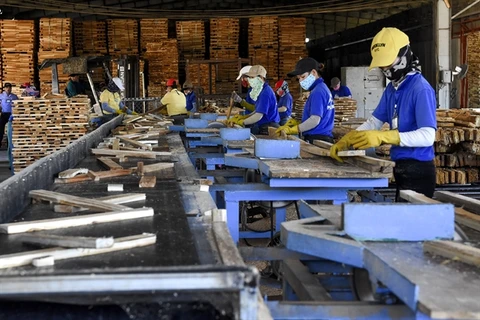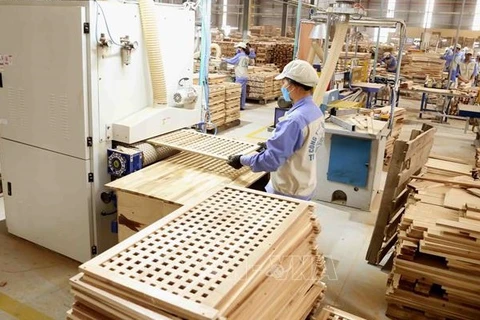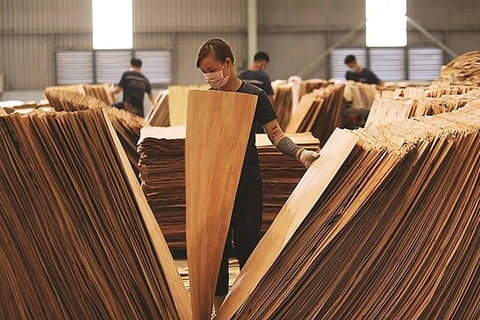Hanoi (VNS/VNA) - Forestry products are one of the few products seeing export growth despite COVID-19 threatening economic development in countries around the world.
However, the impact of the pandemic would be unavoidable in the long term which will force the Vietnamese timber industry to find a new direction to sustain development.
Data of the Ministry of Agriculture and Rural Development showed the export of wood and wood products brought Vietnam more than 13.2 billion USD in the past 11 months, up 20 percent over the same period last year, in which the export of wood products fetched 9.9 billion USD, up 16.6 percent.
“The rapid spread of COVID-19 has changed consumer behaviour, creating pressure and challenges forcing businesses to innovate and improve at all stages, from design and production to trade, in which digitalisation is the key,” said Amit Sharma, lead of researcher team in the report on Digitalisation Maturity Assessment of the Wood Processing Industry in Vietnam.
The report, conducted by the Handicraft and Wood Industry Association of Ho Chi Minh City (HAWA) and the Private Sector Development Research Board (IV Board) under the support of Asia Foundation in Vietnam, has studied the readiness of Vietnam’s wood industry to digital transformation.
The report found 58 percent of respondents confirmed their company has some form of a digital strategy in place and 80 percent said digital transformation is core for their future strategic business development. While 70 percent of firms confirmed their management team has the necessary skills for executing digital transformation, only 48 percent said their company plans its digital strategy for up to two years and 46 percent have a plan from 3-5 years.
Lack of knowledge, process and people are seen as the biggest challenges of developing and implementing a digital strategy, followed by budget and management. Most of the companies said increasing productivity and transforming the company are the core reason for shifting to digitalisation, besides rising revenues, reducing costs and finding new markets.
To achieve exports of 20 billion USD in 2025, it is necessary to approach new directions, multi-channel sales, and increase the value of products. Though e-commerce is the immediate solution, the report said complete digitalisation should be the mid-to-long-term focus of all wood processing Vietnamese enterprises.
According to Pham Thi Ngoc Thuy, director of the office of the IV Board, wood manufacturing businesses have made great efforts to find solutions for digital transformation, especially in the pandemic, business leaders sought many ways to interact with customers given lockdowns in both domestic and foreign markets.
“However, those endeavours are still spontaneous and have yet to create spillovers to the whole industry, so the effect has not been as expected,” Thuy said at the conference on the digital transformation in the wood processing industry on December 15.
She said businesses need to determine where they are in the digital transformation process to make the most accurate action and investment decisions.
Hesitancy
Nguyen Chanh Phuong, HAWA’s vice chairman and general secretary, said up to now, Vietnamese wood enterprises have still maintained some retention towards digitalisation that make them lag far behind counterparts in other countries like China, Germany and Poland.
“Vietnam’s wood industry has a relatively high position in the world’s export map but the contribution of digital transformation and high technology to this result is not much and has not changed the face of the Vietnamese wood industry,” Phuong said.
The furniture segment, which dominates the wood product industry, has four values including production, designing, trading and branding, which have transaction volumes estimated at 450 billion USD per year. However, over the past 20 years, the Vietnamese furniture business community has just focused on the value of production, which has annual transactions of about 140 billion USD with low profit.
Many businesses are sceptical of digital transformation because of high cost pressure. Many do not know where to start and what can be done in the short term and what solutions are needed for the medium and long term. The unwillingness to change is a major challenge to going digital.
Experts have agreed that there is no common answer for digital transformation. Each business has different qualities, so there are also different solutions for their digital strategy. Many companies have begun by examining the factors that create value for their customers and developing operating models to deliver value.
According to Do Xuan Lap, Chairman of the Vietnam Timber and Forest Products Association, a digital transformation programme will help the company improve capacity and corporate governance. Currently, the competitiveness of wood industry enterprises is still low compared to other enterprises, especially foreign-invested enterprises. In the future, the associations will make efforts to help Vietnamese wood enterprises put a digital transformation programme into place./.
However, the impact of the pandemic would be unavoidable in the long term which will force the Vietnamese timber industry to find a new direction to sustain development.
Data of the Ministry of Agriculture and Rural Development showed the export of wood and wood products brought Vietnam more than 13.2 billion USD in the past 11 months, up 20 percent over the same period last year, in which the export of wood products fetched 9.9 billion USD, up 16.6 percent.
“The rapid spread of COVID-19 has changed consumer behaviour, creating pressure and challenges forcing businesses to innovate and improve at all stages, from design and production to trade, in which digitalisation is the key,” said Amit Sharma, lead of researcher team in the report on Digitalisation Maturity Assessment of the Wood Processing Industry in Vietnam.
The report, conducted by the Handicraft and Wood Industry Association of Ho Chi Minh City (HAWA) and the Private Sector Development Research Board (IV Board) under the support of Asia Foundation in Vietnam, has studied the readiness of Vietnam’s wood industry to digital transformation.
The report found 58 percent of respondents confirmed their company has some form of a digital strategy in place and 80 percent said digital transformation is core for their future strategic business development. While 70 percent of firms confirmed their management team has the necessary skills for executing digital transformation, only 48 percent said their company plans its digital strategy for up to two years and 46 percent have a plan from 3-5 years.
Lack of knowledge, process and people are seen as the biggest challenges of developing and implementing a digital strategy, followed by budget and management. Most of the companies said increasing productivity and transforming the company are the core reason for shifting to digitalisation, besides rising revenues, reducing costs and finding new markets.
To achieve exports of 20 billion USD in 2025, it is necessary to approach new directions, multi-channel sales, and increase the value of products. Though e-commerce is the immediate solution, the report said complete digitalisation should be the mid-to-long-term focus of all wood processing Vietnamese enterprises.
According to Pham Thi Ngoc Thuy, director of the office of the IV Board, wood manufacturing businesses have made great efforts to find solutions for digital transformation, especially in the pandemic, business leaders sought many ways to interact with customers given lockdowns in both domestic and foreign markets.
“However, those endeavours are still spontaneous and have yet to create spillovers to the whole industry, so the effect has not been as expected,” Thuy said at the conference on the digital transformation in the wood processing industry on December 15.
She said businesses need to determine where they are in the digital transformation process to make the most accurate action and investment decisions.
Hesitancy
Nguyen Chanh Phuong, HAWA’s vice chairman and general secretary, said up to now, Vietnamese wood enterprises have still maintained some retention towards digitalisation that make them lag far behind counterparts in other countries like China, Germany and Poland.
“Vietnam’s wood industry has a relatively high position in the world’s export map but the contribution of digital transformation and high technology to this result is not much and has not changed the face of the Vietnamese wood industry,” Phuong said.
The furniture segment, which dominates the wood product industry, has four values including production, designing, trading and branding, which have transaction volumes estimated at 450 billion USD per year. However, over the past 20 years, the Vietnamese furniture business community has just focused on the value of production, which has annual transactions of about 140 billion USD with low profit.
Many businesses are sceptical of digital transformation because of high cost pressure. Many do not know where to start and what can be done in the short term and what solutions are needed for the medium and long term. The unwillingness to change is a major challenge to going digital.
Experts have agreed that there is no common answer for digital transformation. Each business has different qualities, so there are also different solutions for their digital strategy. Many companies have begun by examining the factors that create value for their customers and developing operating models to deliver value.
According to Do Xuan Lap, Chairman of the Vietnam Timber and Forest Products Association, a digital transformation programme will help the company improve capacity and corporate governance. Currently, the competitiveness of wood industry enterprises is still low compared to other enterprises, especially foreign-invested enterprises. In the future, the associations will make efforts to help Vietnamese wood enterprises put a digital transformation programme into place./.
VNA
























